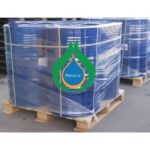Ferric Chloride (FeCl3)
Ferric Chloride, also know as Iron(III) chloride, and Iron chloride, is an industrial scale commodity chemical compound. Its chemical formula is FeCl3 and its CAS is 7705-08-0. When dissolved in water, the compound undergoes hydrolysis resulting in a brown highly corrosive, acidic solution that is used as a flocculent in sewage treatment and drinking water production. Anhydrous iron(III) chloride is a strong Lewis acid that is used as a catalyst in organic synthesis.
Ferric Chloride or Iron (III) Chloride (FeCl3) is used as a flocculant in sewage treatment and drinking water production. When small quantities of ferric chloride are added to the raw water, iron(III) hydroxide precipitates and adsorbs finely divided solids and colloids.
It is usually produced and marketed as a concentrated solution with a minimum concentration of 40% w/w. Starting from this solution is also possible to produce a solid crystallized Ferric Chloride with 37°C melting point.
Consito developed know-how and technologies for ferric chloride 40% w/w solution production plants, both for waste water treatment and drinking water grades.
We can provide for some different processes to produce ferric chloride, according to the feedstock:
- Iron scraps and chlorine gas, by ferric chloride recycling
- Soft iron and chlorine gas, by ferric chloride recycling
- Ferric oxide and hydrochloric acid
- Mixed oxides, hydrochloric acid and chlorine gas
- Pickling liquors and chlorine gas, with final concentration
The raw materials are likewise cheap and easily available so that the manufacture of ferric chloride is frequently an attractive supplement for chlor-alkali producers.
Production process
Ferric chloride 40% w/w solution can be produced by different processes, according to the feedstock.
Iron scraps
Ferrous chloride is obtained by contact of ferric chloride with iron into a dissolution vessel, according to the following reaction:
Fe + 2 FeCl3 = 3 FeCl2
The ferrous chloride solution resulting from iron dissolution is then filtered and oxidized to ferric chloride in the chlorination section by chlorine gas, according to the following reaction:
3 FeCl2 + 1.5 Cl2 = 3 FeCl3
Two third of the ferric chloride solution are recycled back to the dissolution vessel and one third is discharged as product.
Soft iron
This feedstock is a powder of soft iron obtained from rolling-mill process. Production process is analogue to the above description with iron scraps as raw material.
Ferric oxide
Starting from ferric oxide, by product of steel mills, or from hematite, it is possible to obtain ferric chloride by simple reaction with 32% HCl:
Fe2O3 + 6 HCl = 2 FeCl3 + 3 H2O
Mixed oxides
This feedstock is a mixture of ferric oxide and ferrous oxide obtained as scales from rolling-mill process. A previous treatment with 32% HCl followed by chlorination gives place to complete conversion to ferric chloride, according to the following reactions:
Fe2O3 + 6 HCl = 2 FeCl3 + 3 H2O
FeO + 2 HCl = FeCl2 + H2O
FeCl2 + 0.5 Cl2 = FeCl3
Pickling liquors
By a particular process it is possible also to use as feedstock the sludge from steel pickling with HCl. Reduction of chorine consumption is also obtained. Final concentration by evaporation is generally required to reach a 40% w/w solution.
Uses of Ferric Chloride (FeCl3)
- Ferric Chloride is used in organic synthesis as a catalyst.
- It is used to treat over cropping of animal claws especially when the over cropping leads to bleeding.
- It is used as a drying reagent in some reactions in its anhydrous form.
- It has wide applications in energy storage systems.
Preparation of Ferric Chloride
Anhydrous iron (III) chloride can be prepared by reacting metallic iron with dichloride. The chemical equation for this reaction is provided below.
2Fe + 3Cl2 → 2FeCl3
Preparation of Ferric Chloride Solution
- By dissolving iron ore in HCl (hydrochloric acid)
Fe3O4 + 8HCl → FeCl2 + 2FeCl3 + 4H2O
- By oxidizing iron (II) chloride with chlorine (Cl)
2FeCl2 + Cl2 → 2FeCl3
- By oxidizing iron (II) chloride with oxygen
4FeCl2 + O2 + 4HCl → 4FeCl3 + 2H2O
Ferric Chloride Test
This test is conducted to determine the presence or absence of phenol in a given sample. Compounds such as enols, hydroxamic acids, sulfinic acids, and oximes give positive results. The quantity of phenol in the sample can be measured by the Folin-Ciocalteau assay.
Step 1: Dissolve the sample in water plus ethanol.
Step 2: Add drops of a dilute solution of ferric chloride (FeCl3).
Step 3: If the sample turns to red, green, purple, or blue colouration then it indicates the presence of phenols.
Step 4: In case the sample is insoluble in water, it can be dissolved in dichloromethane (CH2Cl2) with a small quantity of pyridine (C5H5N).
Learn more about the physical and chemical properties of Ferric Chloride (FeCl3) from the experts at BYJU’S




